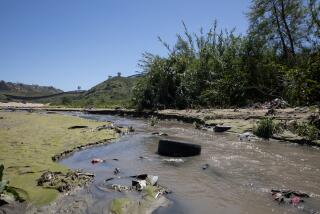Field Lab Neighbors Press for Health Study
SIMI VALLEY — Alarmed by recent revelations about cancer rates at the Santa Susana Field Laboratory, neighbors of Rocketdyne urged elected officials Wednesday to finance a far-reaching study of health and pollution in their communities.
Nearly 100 neighbors of the open-air laboratory packed a meeting room to express concerns about health problems arising from Rocketdyne’s decades-long legacy of nuclear and chemical research.
Listening were members of a panel led by County Supervisor Judy Mikels that included Simi Valley Mayor Greg Stratton, Assemblyman Tom McClintock (R-Northridge) and representatives from the offices of Lt. Gov. Gray Davis, Assemblywoman Sheila Kuehl (D-Santa Monica), state Sen. Cathie Wright (R-Simi Valley), Rep. Elton Gallegly (R-Simi Valley) and U.S. Sen. Barbara Boxer (D-Calif.).
After hearing two hours of testimony, all pledged to press the state Legislature for money for a complete health study, and state and federal government agencies for better oversight of the cleanup at the lab.
Newbury Park resident Sam Rosen spoke of a former field lab neighbor whose husband, a Rocketdyne worker, died of cancer, and who later learned that several of her neighbors had also died of cancer that she believed was caused by exposure to toxins from the Rocketdyne facility.
“The deaths are here, and there must be an explanation,” Rosen said. “We want to get to the bottom of this, that’s all.”
Box Canyon resident Sybil Scotford pleaded with Mikels and other elected officials to get county and state air quality monitoring agencies involved in an investigation of Rocketdyne.
“I got exposed to a gas that was released into the air at 4 a.m. in May of 1989,” but safety data provided by Rocketdyne afterward did not explain what the gas was, she said.
“I’d like to see the state get involved in a serious way,” she said.
“The individuals in this room want answers,” said attorney Helen Zukin, who is pressing property damage and personal injury lawsuits against Rocketdyne on behalf of the field laboratory’s neighbors. “They’re frightened; they want to know what they’ve been exposed to. . . . They need to know what’s in the soil and what’s in the ground water.”
Zukin echoed the residents’ demands for a sweeping, intensive study of health problems among civilians living outside the federally contracted field lab.
She also agreed with many residents’ concerns that government agencies have been too lax in overseeing cleanup of chemical and radioactive material spilled on-site--some of which has flowed off-site and been found in ground water.
“I believe the government has failed this community,” Zukin said. “The government has not done a good job of supervising the cleanup.”
Woodland Hills resident Ray O’Connor said his daughter died of thyroid cancer that he believed was caused by pollution from the lab. O’Connor said eight of 10 people in his neighborhood have some connection to a death from cancer.
And he cited the vague warning that Rocketdyne gave to him when he was teaching school in the San Fernando Valley in 1959, the year one of the lab’s nuclear reactors suffered a partial fuel meltdown. “They told me to keep all my classes inside,” he said.
Attorney Edward Masry, who represents several potential plaintiffs against Rocketdyne, said: “The best thing you politicians can do if you want to shake up Rocketdyne . . . you convene the grand jury, you get these people at Rocketdyne under oath and you find out what was going on up there.”
A group of lab neighbors and activists called the Rocketdyne Cleanup Coalition had convened the hearing with the politicians after a UCLA report last month said that Rocketdyne workers exposed to radiation ran a higher-than-expected risk of dying of cancer.
More to Read
Sign up for Essential California
The most important California stories and recommendations in your inbox every morning.
You may occasionally receive promotional content from the Los Angeles Times.










